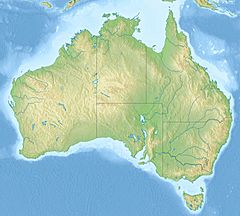Tarragal Caves facts for kids
| Location | near the towns of Tarragal and Cape Bridgewater, Victoria |
|---|---|
| Region | Australia |
| Coordinates | 38°19′7.1″S 141°24′28″E / 38.318639°S 141.40778°E |
| Site notes | |
| Excavation dates | 1970s |
| Archaeologists | Harry Lourandos |
The Tarragal Caves are a group of large limestone caves and rockshelters. They are located near the towns of Tarragal and Cape Bridgewater, Victoria, in Australia. These caves overlook the beautiful Bridgewater Lakes. They are also close to the Discovery Bay Coastal Park.
Contents
A Peek into the Past: Ancient Campsites
The Tarragal Caves were very important to Aboriginal people long ago. They used these caves as camping places. In the late 1970s, a scientist named Harry Lourandos studied the caves. He dug into the ground inside them.
What Scientists Found
Harry Lourandos found amazing things deep in the cave floors. He discovered layers of earth that were 11,300 years old. These layers showed how people lived there. He also found old shell piles, called shell middens. These are like ancient rubbish dumps. They show what people ate. He also found earth ovens, which are places where people cooked food. These ovens were over 11,000 years old.
Exploring the Caves Today
The Tarragal Caves are easy to reach. They are just off Bridgewater Lakes Road. You can walk along a track to get to some parts of them. The cave openings offer clear views. You can see the lakes and the land around them.
Mysterious Underground Passages
One of the caves goes deep underground. It is said to be over 400 meters long. This cave has a special opening called a sinkhole. The sinkhole goes all the way to the surface. This creates a constant flow of air through the cave. It is like the cave is breathing. Old stories say that Aboriginal people would drop wood into this hole. They did this to show respect to the mysterious beings they believed lived inside.
Early Visitors and Their Stories
A colonial administrator named Charles La Trobe visited the caves. He came in 1845 and 1846. His men helped him explore. They lowered a rope ladder down the cliff. This let him get into the caves.
La Trobe's Discoveries
In 1846, La Trobe wrote about his visit. He noted that local Aboriginal people called it 'Lubras’ Cave'. They knew the caves well. But they also had a special respect for them. They believed that spirits lived in the deep parts of the caves. La Trobe saw a large pile of wood under the sinkhole. He thought Aboriginal people had thrown these pieces down over many years.
La Trobe and his men set fire to the wood. The fire lit up the cave. He described a "magnificent vaulted chamber." It had long, shiny stalactites hanging down. Many bats lived there. Their sounds were probably what the Aboriginal people thought were the sounds of supernatural beings.
Art Inspired by the Caves
An old drawing shows an Aboriginal family at the cave entrance. This picture was likely inspired by La Trobe's writings. It helps us imagine what the caves looked like long ago.
Clues from the Earth: Pollen Analysis
Scientists also study the dirt inside the caves. They look at tiny bits of pollen. Pollen is like dust from plants. By studying it, they can learn about the climate. They can also understand what the environment was like thousands of years ago. This helps us know what plants and animals were available to Aboriginal people.
See also


